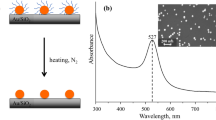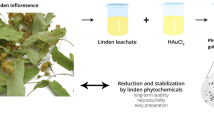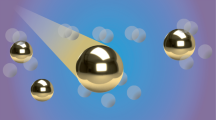Abstract
Cellulose hydrogels are “green” reductants and supports for Au nanoparticles (Au NPs). Herein, we report a facile method for synthesizing Au NPs based on alkali/urea regenerated cellulose hydrogels. By controlling the precursor concentration and the reaction temperature, the size of the Au NPs can be adjusted. We successfully demonstrate that the Au NP/cellulose hydrogels can be used as efficient heterogeneous catalysts in the reduction of 4-nitrophenol (4-NP). Au NPs with smaller sizes have higher catalytic activity. The highest turnover frequency (TOF) of the Au NPs/cellulose hydrogels is 19.4 h−1. The Au NP/cellulose hydrogels can be easily isolated after the catalytic reaction.
Similar content being viewed by others
Login or create a free account to read this content
Gain free access to this article, as well as selected content from this journal and more on nature.com
or
References
Kang H, Liu R, Huang Y. Cellulose-based gels. Macromol Chem Phys. 2016;217:1322–34.
Han Y, Wu X, Zhang X, Zhou Z, Lu C. Reductant-free synthesis of silver nanoparticles-doped cellulose microgels for catalyzing and product separation. ACS Sustain Chem Eng. 2016;4:6322–31.
Cai J, Liu S, Feng J, Kimura S, Wada M, Kuga S, Zhang L. Cellulose–silica nanocomposite aerogels by in situ formation of silica in cellulose gel. Angew Chem. 2012;124:2118–21.
Sakai T, Enomoto H, Torigoe K, Sakai H, Abe M. Surfactant- and reducer-free synthesis of gold nanoparticles in aqueous solutions. Colloids Surf A. 2009;347:18–26.
Mandal S, Selvakannan P, Phadtare S, Pasricha R, Sastry M. Synthesis of a stable gold hydrosol by the reduction of chloroaurate ions by the amino acid, aspartic acid. Proc Indian Acad Sci-Chem Sci. 2002;114:513–20.
Lucía BS, Jorge OT. Size dependence of refractive index of gold nanoparticles. Nanotechnology. 2006;17:1309–15.
Kalishwaralal K, Gopalram S, Vaidyanathan R, Deepak V, Pandian SRK, Gurunathan S. Optimization of alpha-amylase production for the green synthesis of gold nanoparticles. Colloids Surf B-Biointerfaces. 2010;77:174–80.
Huang X, Wu H, Liao XP, Shi B. One-step, size-controlled synthesis of gold nanoparticles at room temperature using plant tannin. Green Chem. 2010;12:395–9.
Lin X, Wu M, Wu D, Kuga S, Endo T, Huang Y. Platinum nanoparticles using wood nanomaterials: eco-friendly synthesis, shape control and catalytic activity for p-nitrophenol reduction. Green Chem. 2011;13:283–7.
Wu M, Kuga S, Huang Y. Quasi-one-dimensional arrangement of silver nanoparticles templated by cellulose microfibrils. Langmuir. 2008;24:10494–7.
Yokota S, Kitaoka T, Sugiyama J, Wariishi H. Cellulose I nanolayers designed by self-assembly of its thiosemicarbazone on a gold substrate. Adv Mater. 2007;19:3368–70.
Benaissi K, Johnson L, Walsh DA, Thielemans W. Synthesis of platinum nanoparticles using cellulosic reducing agents. Green Chem. 2010;12:220–2.
Du M, Huang J, Sun D, Li Q. Propylene epoxidation over biogenic Au/TS-1 catalysts by Cinnamomum camphora extract in the presence of H2 and O2. Appl Surf Sci. 2016;366:292–8.
Jin Y, Zhuang DY, Yu NY, Zhao HH, Ding Y, Qin LS, Liu JF,Yin DH, Qiu HY, Fu ZH, Yin DL. Epoxidation of styrene over gold nanoparticles supported on organic–inorganic hybrid mesoporous silicas with aqueous hydrogen peroxide. Micropor Mesopor Mat. 2009;126:159–65.
Ganguly G, Sultana M, Paul A. Photochemical hydrogenation of CO2 to CH3OH and pyridine to 1,2-dihydropyridine using plasmon-facilitated chemisorbed hydrogen on Au surface: theoretical perspective. J Phys Chem C. 2017;121:15326–32.
Patil NS, Uphade BS, McCulloh DG, Bhargava SK, Choudhary VR. Styrene epoxidation over gold supported on different transition metal oxides prepared by homogeneous deposition-precipitation. Catal Commun. 2004;5:681–5.
Liu XY, Wang AQ, Wang XD, Mou CY, Zhang T. Au-Cu Alloy nanoparticles confined in SBA-15 as a highly efficient catalyst for CO oxidation. Chem Commun. 2008;78:3187–9.
Lin X, Wu M, Kuga S, Endo T, Huang Y. Synthesis of controllable monodisperse gold nanoparticles using wood material and their catalytic activity for p-nitrophenol reduction. Polym J. 2016;48:919–23.
Zeng J, Zhang Q, Chen JY, Xia YN. A comparison study of the catalytic properties of Au-based nanocages, nanoboxes, and nanoparticles. Nano Lett. 2010;10:30–35.
Ebrahimi F. Nanocomposites-new trends and developments. 2012. https://doi.org/10.5772/3389 ISBN978-953-51-0762-0
Van Rie J, Thielemans W. Cellulose-gold nanoparticle hybrid materials. Nanoscale. 2017;9:8525–54.
Wu X, Lu C, Zhou Z, Yuan G, Xiong R, Zhang X. Green synthesis and formation mechanism of cellulose nanocrystal-supported gold nanoparticles with enhanced catalytic performance. Environ Sci. 2014;1:71–9.
Yang Y, Wang X, Yang F, Shen H, Wu D. A universal soaking strategy to convert composite hydrogels into extremely tough and rapidly recoverable double-network hydrogels. Adv Mater. 2016;28:7178–84.
Cai J, Kimura S, Wada M, Kuga S. Nanoporous cellulose as metal nanoparticles support. Biomacromolecules. 2008;10:87–94.
Liu YY, Hu JQ, Kong QC, Feng XM. Shape-controlled synthesis and application in surface-enhanced Raman scattering of novel palladium nanoparticles. Mater Lett. 2010;64:422–4.
Chen M, Kang H, Gong Y, Guo J, Zhang H, Liu R. Bacterial cellulose supported gold nanoparticles with excellent catalytic properties. ACS Appl Mater Interfaces. 2015;7:21717–26.
Lam E, Hrapovic S, Majid E, Chong JH, Luong JHT. Catalysis using gold nanoparticles decorated on nanocrystalline cellulose. Nanoscale. 2012;4:997–1002.
Wang Y, Wei G, Zhang W, Jiang X, Zheng P, Shi L, Dong A. Responsive catalysis of thermoresponsive micelle-supported gold nanoparticles. J Mol Catal A. 2007;266:233–8.
Gao Y, Ding X, Zheng Z, Cheng X, Peng Y. Template-free method to prepare polymer nanocapsules embedded with noble metal nanoparticles. Chem Commun. 2007;36:3720–2.
Zhang M, Liu L, Wu C, Fu G, Zhao H, He B. Synthesis, characterization and application of well-defined environmentally responsive polymer brushes on the surface of colloid particles. Polymer. 2007;48:1989–97.
Chang Y-C, Chen D-H. Catalytic reduction of 4-nitrophenol by magnetically recoverable Au nanocatalyst. J Hazard Mater. 2009;165:664–9.
Acknowledgements
This work was supported by the Natural Science Foundation of Hebei Province (No.E2018210125) and Hebei Key Discipline Construction Project.
Author information
Authors and Affiliations
Corresponding author
Ethics declarations
Conflict of interest
The authors declare that they have no conflict of interest.
Electronic supplementary material
Rights and permissions
About this article
Cite this article
Lin, X., Han, X. & Wang, J. In situ synthesis of easily separable Au nanoparticles catalysts based on cellulose hydrogels. Polym J 50, 495–501 (2018). https://doi.org/10.1038/s41428-018-0044-8
Received:
Revised:
Accepted:
Published:
Issue Date:
DOI: https://doi.org/10.1038/s41428-018-0044-8
This article is cited by
-
Recent Approaches on the Application of Agro Waste Derived Biocomposites as Green Support Matrix for Enzyme Immobilization
Journal of Polymers and the Environment (2022)
-
Bio-nanocomposite Polymer Hydrogels Containing Nanoparticles for Drug Delivery: a Review
Regenerative Engineering and Translational Medicine (2021)



